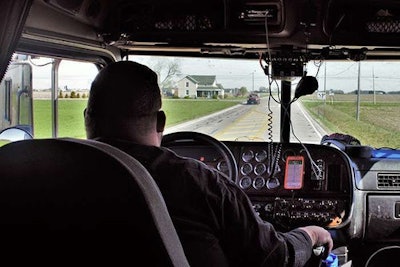
There’s plenty of stress mounting in the trucking industry. A new administration in the White House is closely studying transportation and aiming for big changes, fuel prices are rising along with insurance rates and, one year later, COVID-19 still poses challenges for businesses and their employees.
But when taking a closer look at fleet concerns, it’s easy to see that driver retention outranks them all. According to a recent motor carrier survey conducted by Commercial Carrier Journal, driver retention was the biggest challenge for fleets in 2020 and was projected to be the biggest challenge in 2021.
Of course, that’s hardly big news. Driver tenure issues have been ongoing for quite some time and hinge on a number of factors according to WorkHound, a job retention analytics company that relies on anonymous employee surveys to help companies, including fleets, take corrective action before frustrated workers head for the door.
Some of the bigger factors impacting job retention, according to WorkHound, include stress level, concerns about pay, long hours, perceived lack of respect, lack of work-life balance and an increasing transitory culture particularly among younger employees.
[Related: Truckload fleet uses voice intelligence to monitor calls]
A recent Gallup pole found that 21% of millennials working in various industries across the U.S. changed jobs in the past year – three times the amount of job hopping for employees outside of this demographic. That’s hardly good news for fleets striving to get young and promising talent behind the wheel.
“From the data I've seen, the average tenure of a millennial at a company is 18-36 months,” WorkHound CEO and co-founder Max Farrell said in regards to millennials in various career fields around the U.S.
Making matters even more troublesome has been COVID-19 causing huge lifestyle adjustments at work and at home.
More concerns pile up as the recently enthroned Biden administration (or at least seemingly enthroned given an unprecedented onslaught of executive orders, a transportation decree among them) increases its focus on the transportation industry on various fronts, including for purposes of further reducing emissions and reaching carbon neutral goals. The uncertainty can lead to additional stress at trucking companies.
“This is about Joe Biden. This is about a war on energy and so you’re going to see, unfortunately, fuel prices skyrocket,” said Grant Stinchfield, a popular host on Newsmax, who also runs ten Kenworth T680s at his company GPS LineHaul in Dallas, Texas which is contracted with a Fortune 500 company for long-haul loads.
Rising fuel prices can of course impact the bottom line for fleets that are trying to remain competitive in hiring and retaining the best drivers in the market.
High-tech solutions can help
With people distracted by national events and struggles mounting in their personal and work lives, communication becomes even more important for building and maintaining trust and appreciation between drivers and the fleets they work for.
A growing amount of high-tech solutions are rolling out in the market that are quickly improving communication and actionable intelligence for those managing the complexities of life on the road, as well as office employees crunching the numbers and working the phone lines.
CCJ Senior Editor Aaron Huff wrote this week about Dialpad and Ten5, two companies that use smartphone technology paired up with analytics software designed to prioritize problems and help fleet employees, including drivers, to put resolutions to work as soon as possible.
[Related: Experts report empathy, respect as key to driver retention]
An old question emerges for fleets that continue to go on big hiring binges to fill seats yet struggle with high-turnover: How’s that working for you?
Farrell said big hiring campaigns aren’t always the answer.
“While driver retention may be a top concern for carriers, there are still carriers who are reactively addressing it via recruiting,” Farrell explained. “They simply are expecting that they're going to lose drivers and therefore recruiting more drivers will fill the leaky bucket. This never allows them to stabilize their culture or the problem of driver turnover. They are always one or two steps behind.
“The most innovative companies are creating ‘a culture of curiosity’ where feedback is used to proactively address their culture problems while stabilizing the revolving door of drivers at their company,” Farrell continued. “It's one thing to admit on the CCJ fleet survey that driver retention is a concern, it's a completely different thing to accept that this is a resolvable concern, and we're seeing carriers resolve it through continuous driver feedback.”
[Related: Fleets see electric trucks as driver retention tool]
Opportunities for better communication are there for the taking, Farrell said, so long as fleets are willing to do their part.
“If companies are maintaining communication with a driver from recruiting to onboarding to tenure, there won't be surprises later on, like a truck abandoned on the side of a road. Drivers are coachable and so are carriers. While the push to hire more drivers might be forcing carriers to compromise their discretion in vetting, what it's really causing is a compromise in thorough trust-building between the carriers and drivers.”













